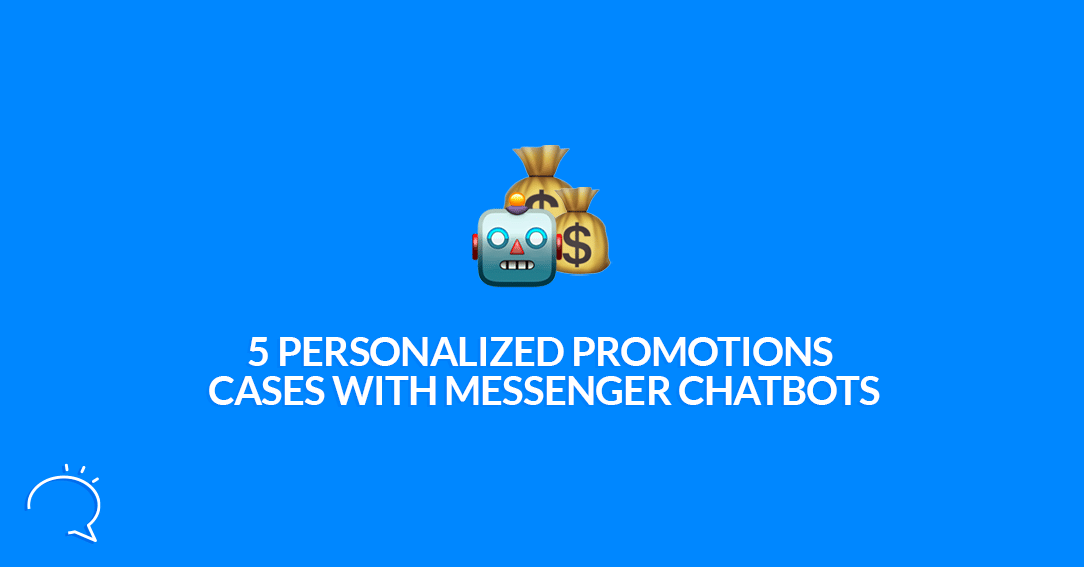Before we dive into the 5 personalized promotions cases, let’s get some backstory first. See, according to IBM, Businesses spend $1.3 trillion on customer service requests. Totaling over 265 billion customer issues. It’s a HUGE investment. As someone that does business online, you know customer support is critical. Especially if you’re after an excellent reputation and a long business life span. No company can sustain bad reviews and unanswered emails or calls for long. And savvy as you are, you know losing customers is more costly than almost any other business investment.
Still, there has to be a better way—right? Luckily, the development of chatbots such as the Facebook Messenger Chatbot tech that first surfaced in 2016 may be the answer. Businesses can save big using chatbots and personalizing promotions. Chatbots aren’t the solution to all customer service problems yet. But, chatbots can increase your business’s productivity and performance. By dealing with simple, but time-consuming requests, sales teams are free to do work that matters.
This article will evaluate 5 key success stories of personalized promotions on Messenger. These 5 examples helped businesses get a step ahead of their competition. But first, let’s run through what chatbots are and how they work in a business setting. If you’re already familiar with the technicals – feel free to skip to the case studies in part 2.
Part One: How the Messenger Chatbot Works
The stats that float around are impressive. Like this one, Gartner claims that 85% of customer interactions will not need a human agent by 2020). Or another one that states the same statistic but delays its deadline to 2021. Regardless of stat estimations, chatbots can and do save businesses revenue and time. And that’s never bad news. Bots are designed to simulate a human conversation with customers or potential customers. Chatbots aren’t necessarily only on messaging apps; they can be installed on any application or website. But, Messenger integration by Facebook in 2016 made Chatbots simpler to install.
That said. Chatbots can be complicated to build without a platform that simplifies the process. Coding your chatbot from scratch is time-consuming and takes lots of investment. Facebook’s chatbot API allows you to create chatbots quicker and easier. Working with a partner like Clepher makes chatbot creation a breeze.
Rule-Based or AI Chatbots?
Chatbots fall into two categories, either rule-based chatbots or AI chatbots:
- Rule-based chatbots are clickable options and responses, much like Netflix’s Black Mirror “Bandersnatch” episode. Different choices produce different outcomes.
- AI chatbots on Messenger can analyze messages and reply by forming complex sentences. The chatbot forms sentences from thousands of different elements—the optimal result—a human-like conversation with a helpful customer support agent.
Messengers Are More Popular Than Social Networking
Messaging apps are already predominant social platforms. Facebook Messenger has 1.3 billion users. An astronomical number that rivals most social media platforms. Total users on messaging apps outnumbered users on social networks since 2014! Even Zuck himself stated in a public Q&A in 2014: “Messaging is one of the few things people do more than social networking.” The top 3 messaging apps (Whatsapp, Messenger, and WeChat) outnumber the top 3 social platforms (Facebook, Twitter, and Instagram). Human social nature powers our interest in people we know and a desire to find interest in us. Notifications, curiosity, gossip, news, rumor, and constant updates always reach us via Messaging Apps. People are now expected to be online or available 24/7. Whether for good or bad, messenger apps are undeniably popular. Any decent marketer knows to go where the attention already exists… and messaging apps are that place.
How Messenger Chatbots Aid Businesses
Now we know how chatbots work. We also know that Messenger is the place to go for massive organic reach. But how do chatbots benefit businesses? Let’s apply what we learned earlier.
Benefits to Customers
Consistency is key to great branding. Talking to a customer service agent gives no guarantee you receive the same answer each time. That can be confusing and frustrating for customers. Not to mention that customers might call several times as a result. Chatbots can provide consistent answers and responses that are transparent and clear. Bots also answer customers instantly… and can answer thousands of questions at the same time. Customers get no record of conversations with customer service agents. With chatbots, customers can screenshot or record interactions to remember instructions or directions. Bots are also infinitely patient and can help keep consumer satisfaction high.
Since chatbots are available 24/7, they can take a significant workload from your sales team. Rather than making sales teams redundant… Have your reps focus on tricky questions and improve the customer experience! Customer experience is becoming the key differentiator of brands. With more time and energy, sales team members will have more energy and patience to deal with challenging queries. Plus, 24/7 availability means that customers won’t be left waiting while the sales team is out of the office or busy. Businesses should be wary that advertising 24/7 availability could backfire. If bot services are temporarily unavailable and the team is offline, customers will be left alone…
Lastly, chatbots can instantly personalize their responses. They can do this based on chat history, customer information, and buying habits. While it may take time before personalization works seamlessly… it is certainly something to take into account.
Business Benefits
While businesses enjoy improvements to the customer experience. Chatbots can grow revenue, as well.
Here are a few examples of revenue-boosting benefits:
First, while chatbots aren’t free, bots’ investment costs are lower than new hires, especially for scaling companies. Hiring, training, and paying salaries is always more costly than using a chatbot. On certain occasions, chatbots can fill gaps in customer support. Some estimate that bots could grow cost savings in the banking industry to $7.3 billion by 2023.
Frictionless interactions with customers, even during their shopping experience, can boost sales significantly. Personalizing promotions during customer searches and shopping can help increase sales. Regardless, reduced waiting time for purchase-related questions helps close the gap of lost sales. Increased customer interactions is an increase in opportunities to sell or increase sales. Customers often have one or two purchases in mind. Yet since chatbots know all existing products, they can encourage more purchases.
Bots that run on popular messaging platforms, like Messenger, can reach new customers. Messenger isn’t merely a messaging platform. It allows businesses to target consumers, like existing customers using customer data, via FB ads. Messenger also brings the possibility to collect new data from customers using feedback cues. Feedback from bots can be used to collect common frustrations automatically. And they can be sorted by priority. Marketing and design teams can use this to adapt their sales platform to alleviate problems.
Part 2: Case Studies of Personalizing Promotions
With a fundamental understanding of how bots work… and what they can do for your business, let’s look at practical examples! These 5 case studies exemplify personalized promotion success. Whether you want to raise the profile of products, brands, or events—chatbots can help. They showcase the strategic power of Messenger Chatbots.
Happy Socks Put Their Best Foot Forward
Happy Socks is a sock company that sells fun and festive high-quality socks. They do this across more than 90 countries. Using Messenger campaigns, Happy Socks received a 2.4X return on ad spendings for a Christmas campaign. Happy Socks also took in a 3X return on their Valentine’s Day campaign. Happy Socks had a custom bot designed to assist people with their shopping. The bot focused on interested customers shopping for gifts for the holidays.

Happy Socks
HS targeted its personalized promotions to men and women in 25 countries between 20 and 50 years old. With a complex array of sock styles… HappySocks’ Messenger campaign helped customers find the right pair. Messenger experiences were directly linked to video and link ads on Instagram and Facebook. The company focused on a playful and fun interaction with the bot.
DBS Banked on Messenger Success
Speaking of banking, the Singapore-based bank DBS partnered with coffee and tea merchant… Kopi Ong. Their Messenger experience allowed customers to order and pay for drinks using a bot. DBS wanted to explore bank friendly options to order food and beverages at quick-service restaurants. Interestingly, customers began to order drinks while en-route to Kopi Ong. The ordering process removed much of the staff’s repetitive tasks. Allowing them to focus on making the beverages.
The bots eliminated time spent waiting and queuing for orders. Customers who didn’t order in advance had more time to order and converse with staff. The result was better communication and customer satisfaction. Targeted promotions in the Messenger app gave potential customers more incentive to order through the app than in person. Human interaction actually increased as the staff wasn’t as loaded with tasks.
The result:
- 30% reduction in peak hour queue time
- 20% increase in sales without new hires
The Messenger chatbot is now a permanent solution at Kopi Ong.
Anchor Jobs: Englands Leading Non-Profit Care Provider
Anchor Jobs is a recruitment charity agency. They help find paid caregivers and social workers. The charity was seeking ways to optimize donation money spending. Using Messenger, the applicant cost dropped by 68%, and job applications increased by 1.7X. Ad links directed users to Messenger chats. Here, bots would answer questions and gather potential applicant data. Bots requested a few answers to see if applicants would be a good fit for the role. If so, the bot would ask the applicant for their contact information. This way, the hiring team could contact them. Personalizing promotions enabled Anchor Jobs to reach people who were most likely to be interested in working there. They did this by comparing potential applicants to their most engaged customers.
LG Put’s a New Spin on Laundry Mishaps
The global appliance company, raised purchase intent by 4.3X. LG wanted to raise awareness of its new technology. Dubbed the TWINWash system, LG enabled customers to wash two separate loads simultaneously. LG intended to encourage potential customers to share photos of their laundry failures. And then it determined how TWINWash could help. Videos were showcasing other customer laundry failures linked to the Messenger experience. LG used personalized promotions to target people between 29 and 54 years old.
The campaign ran during peak sale seasons in respective countries. The Messenger experience featured bot questions and corresponding answers, and the conversation came pre-installed with an AR feature. They did this to project how the machine would look in the potential customers’ house. Weblinks, promotions, and offers peppered the chat. Of course, along with a giveaway event in Messenger. LG made 656 million impressions and 60,000 engagements in Messenger. Most of all, a 6.6% increase in brand recall in essential regions.
Shop Direct Made a Christmas Miracle
The digital retail company deployed Messenger to take customers through the Very.co.uk range of products. The retail company earned £4.9 million in incremental sales due to a 38X ROI. Very.co.uk already made 74% of sales through mobile devices on its website. For the 2018 Christmas holiday campaign… Shop Direct created began personalizing promotions towards all UK adults. Their new Messenger chatbot was developed to be a friendly helper to help find the perfect gift for a child. After gathering data on the child’s age and interests… “Elsie” suggested a potential gift within a price range. From Elsie’s suggestion, customers could click straight through to a purchase.
Chat With Us
We hope this breakdown inspired you to find a chatbot business solution for your company! If so, please get in contact with us as soon as possible. Building a bot and personalizing promotions can be complicated. But, Clepher makes it easy and intuitive. Messenger apps are dominating customer attention but are still vastly underpriced. Take advantage of this option and invest in a chatbot for your next big product, campaign, or hiring spree. We look forward to hearing your results.
Related Posts



